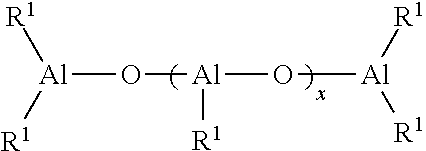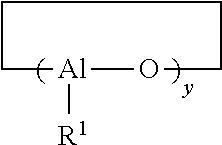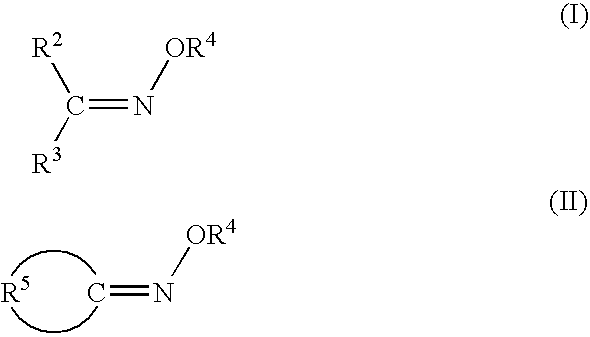Polymers functionalized with protected oxime compounds
a technology of functionalized polymers and oxime compounds, applied in the field of functionalized polymers, can solve the problems of unpredictable prediction of whether a reactive polymer can be functionalized by treatment with a particular functionalizing agent, and achieve the effect of reducing hysteresis
- Summary
- Abstract
- Description
- Claims
- Application Information
AI Technical Summary
Benefits of technology
Problems solved by technology
Method used
Image
Examples
example 1
Synthesis of Unmodified cis-1,4-Polybutadiene (Control Polymer)
[0110]To a 2-gallon reactor equipped with turbine agitator blades was added 1403 g of hexane and 3083 g of 20.6 wt % butadiene in hexane. A preformed catalyst was prepared by mixing 7.35 ml of 4.32 M methylaluminoxane in toluene, 1.66 g of 20.6 wt % 1,3-butadiene in hexane, 0.59 ml of 0.537 M neodymium versatate in cyclohexane, 6.67 ml of 1.0 M diisobutylaluminum hydride in hexane, and 1.27 ml of 1.0 M diethylaluminum chloride in hexane. The catalyst was aged for 15 minutes and charged into the reactor. The reactor jacket temperature was then set to 65° C. Fifty three minutes after addition of the catalyst, the polymerization mixture was cooled to room temperature. The resulting polymer cement was coagulated with 12 liters of isopropanol containing 5 g of 2,6-di-tert-butyl-4-methylphenol and then drum-dried. The Mooney viscosity (ML1+4) of the polymer was determined to be 29.4 at 100° C. by using a Monsanto Mooney viscom...
example 2
Synthesis of Unmodified cis-1,4-Polybutadiene (Control Polymer)
[0111]To a 2-gallon reactor equipped with turbine agitator blades was added 1651 g of hexane and 2835 g of 22.4 wt % butadiene in hexane. A preformed catalyst was prepared by mixing 5.88 ml of 4.32 M methylaluminoxane in toluene, 1.22 g of 22.4 wt % 1,3-butadiene in hexane, 0.47 ml of 0.537 M neodymium versatate in cyclohexane, 5.33 ml of 1.0 M diisobutylaluminum hydride in hexane, and 1.02 ml of 1.0 M diethylaluminum chloride in hexane. The catalyst was aged for 15 minutes and charged into the reactor. The reactor jacket temperature was then set to 65° C. Seventy minutes after addition of the catalyst, the polymerization mixture was cooled to room temperature. The resulting polymer cement was coagulated with 12 liters of isopropanol containing 5 g of 2,6-di-tert-butyl-4-methylphenol and then drum-dried. The resulting polymer had the following properties: ML1+4=44.2, Mn=129,900, Mw=261,200, Mw / Mn=2.01, cis-1,4-linkage=95...
example 3
Synthesis of cis-1,4-Polybutadiene Modified with Formaldehyde O-Benzyloxime (FBO)
[0112]To a 2-gallon reactor equipped with turbine agitator blades was added 1586 g of hexane and 2900 g of 21.9 wt % butadiene in hexane. A preformed catalyst was prepared by mixing 7.35 ml of 4.32 M methylaluminoxane in toluene, 1.57 g of 21.9 wt % 1,3-butadiene in hexane, 0.59 ml of 0.537 M neodymium versatate in cyclohexane, 6.67 ml of 1.0 M diisobutylaluminum hydride in hexane, and 1.27 ml of 1.0 M diethylaluminum chloride in hexane. The catalyst was aged for 15 minutes and charged into the reactor. The reactor jacket temperature was then set to 65° C. Fifty seven minutes after addition of the catalyst, the polymerization mixture was cooled to room temperature. 430 g of the resulting living polymer cement was transferred from the reactor to a nitrogen-purged bottle, followed by addition of 1.81 ml of 1.00 M formaldehyde O-benzyloxime (FBO) in hexane. The bottle was tumbled for 35 minutes in a water ...
PUM
| Property | Measurement | Unit |
|---|---|---|
| temperature | aaaaa | aaaaa |
| temperature | aaaaa | aaaaa |
| temperature | aaaaa | aaaaa |
Abstract
Description
Claims
Application Information
 Login to View More
Login to View More - R&D
- Intellectual Property
- Life Sciences
- Materials
- Tech Scout
- Unparalleled Data Quality
- Higher Quality Content
- 60% Fewer Hallucinations
Browse by: Latest US Patents, China's latest patents, Technical Efficacy Thesaurus, Application Domain, Technology Topic, Popular Technical Reports.
© 2025 PatSnap. All rights reserved.Legal|Privacy policy|Modern Slavery Act Transparency Statement|Sitemap|About US| Contact US: help@patsnap.com



